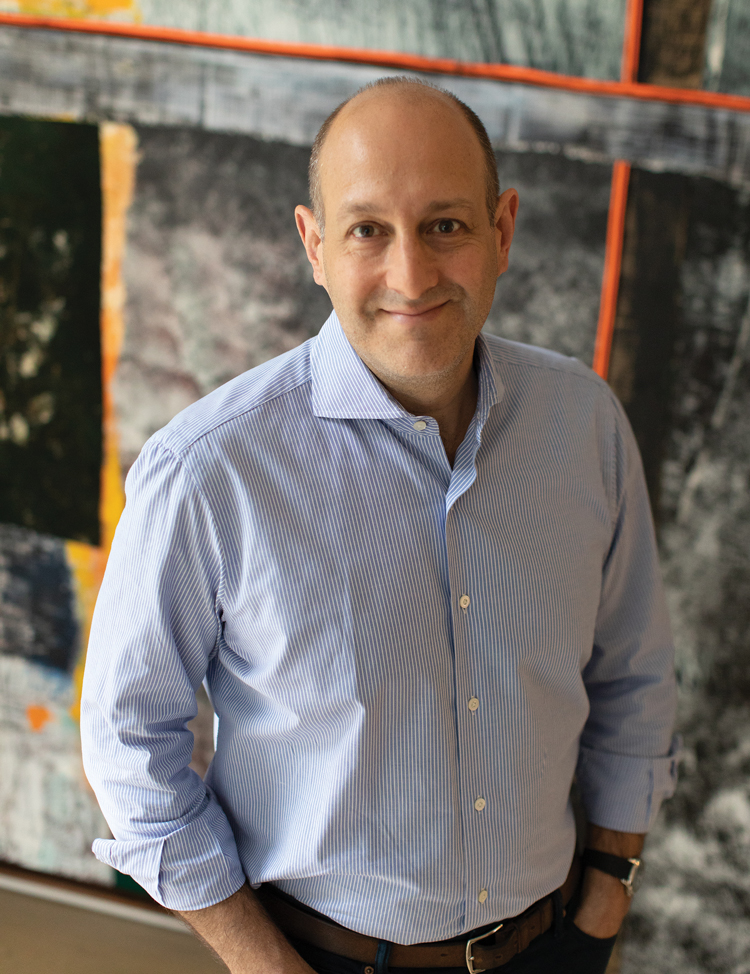[ad_1]

Jose Dávila, Joint Effort, 2017 (foreground), and Antony Gormley’s CONTAIN, 2016 (background), in the garden of Daniel Sallick’s home.
PAUL FRICK/COURTESY DANIEL SALLICK
The author is founding partner of Subject Matter, a Washington, D.C., creative advocacy firm. He is board chair of the Hirshhorn Museum and Sculpture Garden and a board member of the Judd Foundation.
As a young collector 15 years ago, at the dawn of the art fair age, I was vacationing in Paris with my wife and young son when I had what seemed like an audacious idea. Deeply intrigued by Cy Twombly, I wrote to the famed dealer Karsten Greve asking if he would meet with me to discuss the great artist’s work.
Days later, I wound my way through a cobblestone courtyard to Greve’s namesake gallery in the historic yet hip Marais district. Sitting across from him in his meticulously renovated medieval building with polished cement floors, I sipped coffee as Greve showed me a relatively inexpensive hand-drawn poster from a show of Twombly’s at Leo Castelli Gallery in 1964.
The artist’s trademark red-and-black pencil scribbles—alluring, confounding, elegant—were unmistakable, and in the idyllic setting, Greve leafed through old catalogues to explain the nuances of Twombly’s Greek and Roman references. After an hour or so of patiently letting me take it all in, Greve bid me well and we parted ways. Eventually, over two more months of conversation, he negotiated the price down to something I could afford, and though I later sold the poster to another collector, I’ve been hooked on Twombly ever since.
Today, as I get lost dreaming about art and plotting my next acquisition while sitting at my desk in Washington, D.C., that first encounter with Greve seems a world away. Back then, not even so long ago in 2003, few galleries had significant websites or digital marketing managers, and someone just getting interested could methodically court favored artists or even a single artwork.
The contrast struck me this past summer when, during the week leading up to Art Basel, I received 134 emails from galleries around the world. Two-thirds were perfunctory and impersonal, with 20 or 30 images of artworks attached. The rest were more catered to me in particular, with notes ranging from the quick “Will you be in Basel?” to the more pointed “Knowing of your interest in (fill-in-the-blank) artist . . .” Some queries included references to “strong interest” from other collectors or insinuations that future museum shows and acquisitions would lead to rising prices. Pressure to buy was implicit, and I easily surveyed 1,000 digitized images in just a few days. As a likely also-ran for a “Top 1,000 Collectors” list, I can only imagine what the sales pitches look like for those in the highest tiers.
All of it was enough to make me wonder: As dealing and collecting have become digitally fueled, always-on pursuits punctuated by the punishing schedule of the art-fair circuit, would a world-class dealer like Greve—or any dealer, for that matter—have an hour to spare now for a naive young collector on a random afternoon?
The very stature and value of art are fluid in our current digital ecosystem, and connoisseurship is being redefined. The gatekeepers of old—curators, critics, artists—are being challenged by a multitude of players in the growing business of marketing and selling art, much of which happens or is initiated online. Many of us feed our passion by living vicariously through Instagram-posting collectors and dealers for whom the world is a high-priced playground. Their most recent discoveries—from London to Turin, Venice to Hong Kong—make us marvel and wince all at once.
But does the velocity and volume of today’s art world make us better and wiser collectors? How do we ensure that access to valuations won’t undermine our values? How can we guard against letting the endless opportunities for transactions supplant the sublime visual pleasure of standing in front of a masterpiece, even one we will never own?
And, ultimately, can connoisseurship of the kind that Greve and others kindled in me survive in the digital age?
It can if collectors stay mindful of how their world is evolving. One way to think beyond mere collecting and engage art’s lineage—its past, present, and future—is by supporting public museums. Such pillars of our communities are changing the culture for the better, and they need our help. There is no better way to revive connoisseurship, and though altruism can be the impetus, collectors get something, too: invaluable insights from seasoned curators who are thinking about artists’ place in history rather than their lot numbers at Christie’s or Sotheby’s in the fall.
Since joining the Hirshhorn Museum and Sculpture Garden as a board member nearly a decade ago (and serving as chairman since 2016), I have enjoyed a front-row seat to the serious deliberations about the museum’s acquisition and exhibition strategies. What I have learned is that the collecting priorities of curators can diverge wildly from those of the market. The museum’s acquisition of part of the collection of the Italian visionary Giuseppe Panza di Biumo in 2007 exposed me for the first time to incredible conceptual art by On Kawara, Joseph Kosuth, Lawrence Weiner, Douglas Huebler, and many others whose work I follow and collect today. The acquisition of work from one of the 20th century’s great connoisseurs changed the museum forever—and, on a smaller scale, it helped shape and inform my thinking as a collector. Every art lover would benefit from this kind of perspective.
Collectors can also embrace the digital world to go deeper than they could before. Technology can open doors to galleries across the planet and allow collectors like me to connect with people who live a world away—sort of like a contemporary take on my first encounter with Galerie Karsten Greve. A few years back, a single blind email inquiry I sent about a sculpture by Thomas Houseago planted the seed to a connection with the Brussels gallerist Xavier Hufkens. We’ve since enjoyed dinners and coffee meetings in Washington, turning an otherwise cold digital exchange into a warm friendship. When such connections find their way into the real world, insights from international gallerists become their own currency, exporting global perspectives that might not otherwise be available in Washington, London, or New York.

Daniel Sallick with Sterling Ruby’s WIDW WASHER, 2017.
PAUL FRICK/COURTESY DANIEL SALLICK
However it might happen, immersion in the collector community can bring lifelong rewards. Over 20 years of collecting, I have been fortunate that my path intersected with those of true connoisseurs including J. Tomilson Hill, Barbara and Aaron Levine, and Robert Lehrman. I have learned greatly from the strategies and fierce dedication of each, and while collecting is a singular pursuit, paths to building great collections can diverge.
From Hill, I learned about the virtues of patience, deep research, and the willingness to wait years in pursuit of works. I remember talking with him once on the phone and telling him how I was enamored of a widely respected mid-career artist. “You have to decide,” Hill said of the painter, “is he a real game changer?” In that moment, I realized this was a standard I needed to apply.
From the Levines, I have been exposed to the pleasures of collecting what Marcel Duchamp called “non-retinal” art, in which the idea of the work in many cases eclipses its visual appeal. Aaron Levine’s passion for conceptual art has been a lesson all its own, as he can articulate the profundity and meaning in something as fleeting as Duchamp’s 50 cc of Paris Air—a seemingly empty glass bulb full of Parisian ether, conceived in 1919—in ways that rival Clement Greenberg’s passionate defense of Jackson Pollock’s “drip” paintings. For the Levines, the idea is what matters most.
And from Lehrman, never one to follow the herd, I gained the wisdom of not being afraid to “buy on bad news,” as he put it, by collecting artists or works I believe in even when they are out of favor in the market. “Don’t be afraid to buy art you love,” he would say, imploring me instead to think about the long arc of art history.
Although the inclination of some collectors might be to find fault or irrationality in the art market, our energies would be better spent trying to understand it and recognize how it works. Plenty of uncomfortable conversations about pricing happen in hushed tones among both experienced and new collectors who lament fair fatigue and endless efforts to invent and reinvent art history for the sake of driving prices ever higher. We all feel it. But we can’t fault the market for growing and evolving with the times. And, in any case, collectors should be cognizant that today’s career reinvention or hot emerging artist might not be in tomorrow’s museum show. Every collector should do the work required to see the art and assess its value on its own terms so that we’re not so easily seduced by the pitch.
I liken the presence of the market to the omnipresence of technology—like my teenagers with their phones. It might not be the world we want, but it’s the world we have. It is an environment in which art and collecting and technology coexist, and we should adapt and work to navigate it so that we can stay true to ourselves and the art we love.
After two decades of collecting and trying to unlock the mysteries of contemporary art, I am still always reminded that, in its simplest form, the quest is all about art and relationships. Even the most negative caricatures and assumptions about the “art world” and the “art market” don’t diminish the meaningful interactions I have with great people inhabiting this world every day. I am fortunate to have met many dealers, advisers, collectors, and curators who are committed to a long-term dialogue about art and connoisseurship—and, above all, artists who are the real revolutionaries in our society.
A few years ago, I bought a work by one such artist, Joseph Kosuth. Its journey to my home, which started when I first learned about his work during the Hirshhorn’s acquisition of the Panza collection, was a marathon, not a sprint. Sean Kelly, a great dealer and close friend, was certain that Kosuth—an artist of great importance in the evolution of conceptual art—would be perfect for my collection. I read all I could about Kosuth and his ways of thinking, making many visits to Kelly’s immense gallery library. I viewed his work in museums and private homes. I began to see with clarity how Kosuth had always been brash, bold, and intent on blowing up the conventional norms of the day. My interest was ignited, but more than a few times I passed on opportunities to buy Kosuth works that didn’t seem quite right.
Kelly—who can be wickedly funny, passionate, and animated but also pensive and serious—was ever patient. He and I had dozens of conversations along the way, each one deeper than the one before. We argued and laughed and kept the dialogue going. I remember him teaching me and, sometimes, redirecting me. “I don’t just want you to have a Kosuth,” he said. “I want you to have the right Kosuth.”
Eventually Kelly called me once more with a Kosuth work, a so-called “definition” piece from 1968 titled Self-Contained. He thought it was perfect for me because it aligned with who I am and how I see the world. This time, he was right. As we joked later about the life span of our conversation, I went back to discover that our first exchange about my acquiring a Kosuth had occurred seven years earlier.
The work now hangs above the mantel in my living room. As I walk past it every day, I appreciate the slower side of the art world—the one that includes ongoing dialogue about how great art can change your life and how connoisseurship can season your perspective. Each time I see it I remember how nothing can replace that rare privilege of standing in front of an artwork and feeling your heart skip a beat or two.
That, of course, will never change.
A version of this story originally appeared in the Fall 2018 issue of ARTnews on page 56 under the title “Can Connoisseurship Survive in the Digital Age?”.
[ad_2]
Source link

